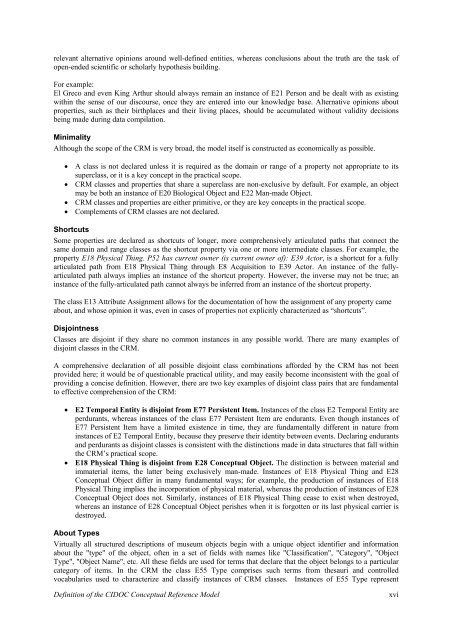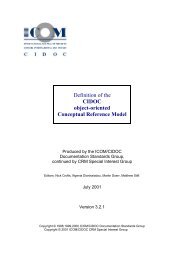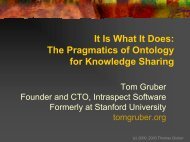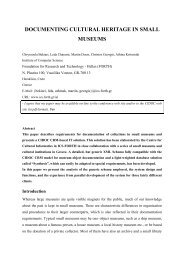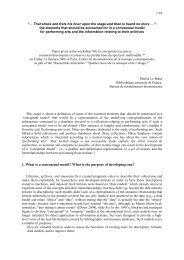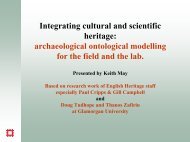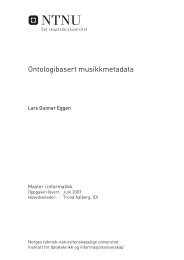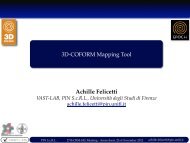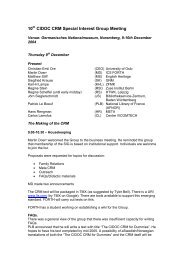pdf file - The CIDOC CRM
pdf file - The CIDOC CRM
pdf file - The CIDOC CRM
You also want an ePaper? Increase the reach of your titles
YUMPU automatically turns print PDFs into web optimized ePapers that Google loves.
elevant alternative opinions around well-defined entities, whereas conclusions about the truth are the task of<br />
open-ended scientific or scholarly hypothesis building.<br />
For example:<br />
El Greco and even King Arthur should always remain an instance of E21 Person and be dealt with as existing<br />
within the sense of our discourse, once they are entered into our knowledge base. Alternative opinions about<br />
properties, such as their birthplaces and their living places, should be accumulated without validity decisions<br />
being made during data compilation.<br />
Minimality<br />
Although the scope of the <strong>CRM</strong> is very broad, the model itself is constructed as economically as possible.<br />
• A class is not declared unless it is required as the domain or range of a property not appropriate to its<br />
superclass, or it is a key concept in the practical scope.<br />
• <strong>CRM</strong> classes and properties that share a superclass are non-exclusive by default. For example, an object<br />
may be both an instance of E20 Biological Object and E22 Man-made Object.<br />
• <strong>CRM</strong> classes and properties are either primitive, or they are key concepts in the practical scope.<br />
• Complements of <strong>CRM</strong> classes are not declared.<br />
Shortcuts<br />
Some properties are declared as shortcuts of longer, more comprehensively articulated paths that connect the<br />
same domain and range classes as the shortcut property via one or more intermediate classes. For example, the<br />
property E18 Physical Thing. P52 has current owner (is current owner of): E39 Actor, is a shortcut for a fully<br />
articulated path from E18 Physical Thing through E8 Acquisition to E39 Actor. An instance of the fullyarticulated<br />
path always implies an instance of the shortcut property. However, the inverse may not be true; an<br />
instance of the fully-articulated path cannot always be inferred from an instance of the shortcut property.<br />
<strong>The</strong> class E13 Attribute Assignment allows for the documentation of how the assignment of any property came<br />
about, and whose opinion it was, even in cases of properties not explicitly characterized as “shortcuts”.<br />
Disjointness<br />
Classes are disjoint if they share no common instances in any possible world. <strong>The</strong>re are many examples of<br />
disjoint classes in the <strong>CRM</strong>.<br />
A comprehensive declaration of all possible disjoint class combinations afforded by the <strong>CRM</strong> has not been<br />
provided here; it would be of questionable practical utility, and may easily become inconsistent with the goal of<br />
providing a concise definition. However, there are two key examples of disjoint class pairs that are fundamental<br />
to effective comprehension of the <strong>CRM</strong>:<br />
• E2 Temporal Entity is disjoint from E77 Persistent Item. Instances of the class E2 Temporal Entity are<br />
perdurants, whereas instances of the class E77 Persistent Item are endurants. Even though instances of<br />
E77 Persistent Item have a limited existence in time, they are fundamentally different in nature from<br />
instances of E2 Temporal Entity, because they preserve their identity between events. Declaring endurants<br />
and perdurants as disjoint classes is consistent with the distinctions made in data structures that fall within<br />
the <strong>CRM</strong>’s practical scope.<br />
• E18 Physical Thing is disjoint from E28 Conceptual Object. <strong>The</strong> distinction is between material and<br />
immaterial items, the latter being exclusively man-made. Instances of E18 Physical Thing and E28<br />
Conceptual Object differ in many fundamental ways; for example, the production of instances of E18<br />
Physical Thing implies the incorporation of physical material, whereas the production of instances of E28<br />
Conceptual Object does not. Similarly, instances of E18 Physical Thing cease to exist when destroyed,<br />
whereas an instance of E28 Conceptual Object perishes when it is forgotten or its last physical carrier is<br />
destroyed.<br />
About Types<br />
Virtually all structured descriptions of museum objects begin with a unique object identifier and information<br />
about the "type" of the object, often in a set of fields with names like "Classification", "Category", "Object<br />
Type", "Object Name", etc. All these fields are used for terms that declare that the object belongs to a particular<br />
category of items. In the <strong>CRM</strong> the class E55 Type comprises such terms from thesauri and controlled<br />
vocabularies used to characterize and classify instances of <strong>CRM</strong> classes. Instances of E55 Type represent<br />
Definition of the <strong>CIDOC</strong> Conceptual Reference Model<br />
xvi


